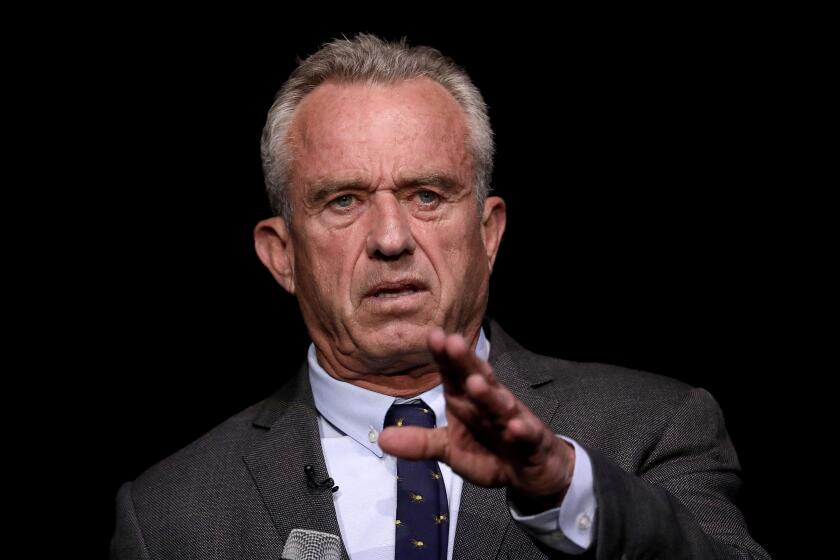Southwest encounters new safety problem
- Share via
Southwest Airlines temporarily grounded several dozen planes and canceled flights Wednesday as the nation’s largest low-cost carrier was hit with its second safety inspection problem in a week.
The Dallas-based airline said it was forced to cancel about 4% of Wednesday’s flights as 38 of its oldest jetliners underwent 90-minute inspections. The action caused only minimal travel disruptions in Southern California, Southwest said.
The extraordinary move to ground the planes came as Southwest faces a $10.2-million fine, one of the biggest ever, for allegedly failing to carry out mandatory inspections.
Gary Kelly, chief executive of Southwest Airline Co., said Wednesday that the carrier was conducting an internal review of the situation and suggested that it potentially could “create other operational changes if the airline needs to swap or reroute aircraft.”
The warning caused alarm on Wall Street, sending shares of Southwest down 91 cents, or 7%, to $11.49.
Southwest’s woes underscore a growing concern within the U.S. airline industry about the age of the jets crisscrossing the country and the need to replace them before maintenance and repairs become too costly.
Domestic carriers last year had begun to see their earnings recover after years of difficulty, only to have high fuel prices dampen the profits needed to replenish their fleets.
Southwest operates a fleet of 520 planes, all 737s. Nearly 150 of them are older 737-300 models built by Boeing Co. in the late 1980s and early ‘90s.
Last week’s fine, unrelated to the issue that grounded the aircraft Wednesday, was imposed by the Federal Aviation Administration because Southwest operated 46 of its older planes last year without performing a required inspection for cracks in its fuselage.
Executives of Southwest said the fuselage case was “never a safety-of-flight issue” and vowed to fight the fine, saying the airline had discovered the lapse, reported it and had since followed FAA regulations.
“We’ve got a 37-year history of very safe operations, one of the safest operations in the world, and we’re safer today than we’ve ever been,” CEO Kelly said in response to the fine.
The fuselage inspections are part of a preventive-maintenance program stemming from a 1988 incident in which the skin of an Aloha Airlines 737 ripped open during an intra-island flight in Hawaii, killing a flight attendant. The safety checks are “designed to protect passengers and crew,” FAA Associate Administrator for Aviation Safety Nicholas A. Sabatini said last week.
FAA officials said the fine was unusually large because Southwest kept flying the planes even after the inspection lapse was discovered. The airline contends that it received approval to do so from a local FAA official in Dallas.
The fine and claims of other potential lapses prompted Southwest on Tuesday to begin the internal review, during which executives discovered another set of inspections that might not have been completed properly. Those involved checks of joints around the windows of some of its oldest 737s.
Kelly said in a statement Wednesday that the airline decided to ground the jets after finding some “ambiguous” wording in the documentation on an inspection that had already been completed.
The planes were grounded until the airline receives clarification from manufacturer Boeing and after they undergo another inspection.
“Southwest made the decision to take a conservative approach and remove aircraft out of scheduled service,” Kelly said.
Ten of about 130 Southwest flights at Los Angeles International Airport were canceled Wednesday but some of them were related to severe weather in Texas, Southwest said. By late Wednesday most of the planes were back in the air.
Southwest placed three employees on paid leave Tuesday while it investigated the allegation that an FAA supervisor in Dallas had verbally allowed the airline to operate the older planes even though they had missed the deadline for the required fuselage inspections.
Acting FAA Administrator Robert A. Sturgell said the events stemmed from “a twofold breakdown in the aviation system”: Southwest’s failure to properly inspect its planes and the FAA’s failure to ground the jets as “at least one FAA inspector looked the other way.”
Southwest passengers meanwhile seemed to be taking the carrier’s problems in stride.
“Southwest has a pretty good safety record, so it was a little surprising that something like this could happen,” said Dustin Romero, a Sacramento resident who was heading home on Southwest from Orange County’s John Wayne Airport.
“But I’m not too worried. I’d rather have my flight canceled or delayed than fly in an unsafe plane.”
More to Read
Inside the business of entertainment
The Wide Shot brings you news, analysis and insights on everything from streaming wars to production — and what it all means for the future.
You may occasionally receive promotional content from the Los Angeles Times.










